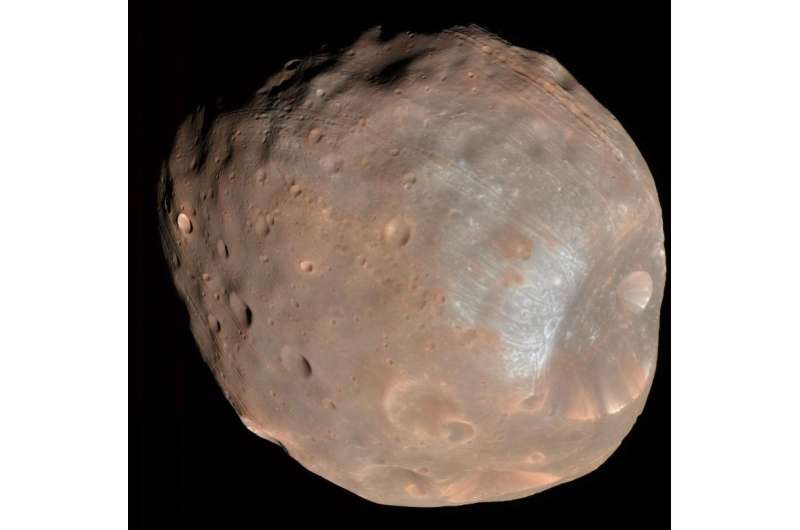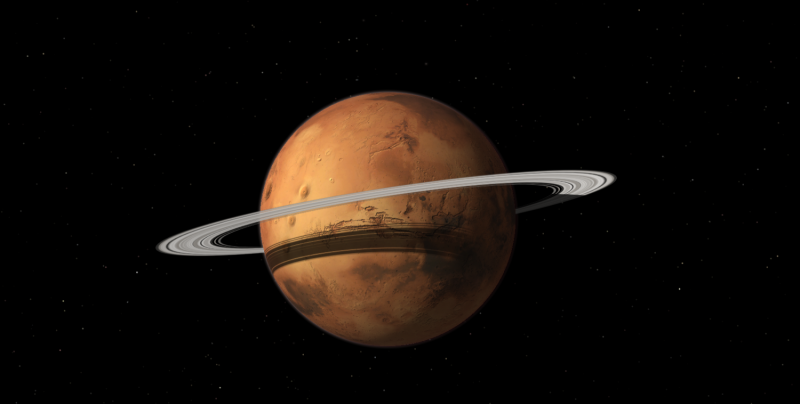In 40 million years, Mars may have a ring (and one fewer moon)

Nothing lasts forever - especially Phobos, one of the two small moons orbiting Mars. The moonlet is spiraling closer and closer to the Red Planet on its way toward an inevitable collision with its host. But a new study suggests that pieces of Phobos will get a second life as a ring around the rocky planet.
In our solar system, the only planets with rings are the gas giants - Jupiter, Saturn, Uranus and Neptune. The study, published Monday in the journal Nature Geoscience, suggests this wasn't always the case. However, the study authors say this is probably the last time a rocky planet will have a chance to sport a ring.
A moon - or moonlet - in orbit around a planet has three possible destinies. If it is just the right distance from its host, it will stay in orbit indefinitely. If it's beyond that point of equilibrium, it will slowly drift away. (This is the situation with the moon; as it gradually pulls away from Earth, its orbit is growing by about 1.5 inches per year.) And if a moon starts out on the too-close side, its orbit will keep shrinking until there is no distance left between it and its host planet.
That will be the ultimate fate of Phobos, as astronomers have known for decades. But Benjamin Black and Tushar Mittal, both planetary scientists at the University of California, Berkeley, wanted to get a clearer picture of what this end would look like.
A lot depends on what Phobos is made of. To find out, Black and Mittal compared spectral data from the small moon with data from other rocky objects. The closest match they found was with a class of meteorites known as CM carbonaceous chondrites - especially those that fell on Canada's frozen Tagish Lake in January of 2000.
Such objects aren't especially strong, the study authors wrote. Phobos has the added weakness of having a low density, which suggests it's very porous, they noted.
Phobos also had the misfortune of getting slammed by a large object that left a roughly 6-mile-wide crater, which covers nearly half of the moonlet's diameter. That impact undermined the moon's integrity even further.
To determine the "rock mass strength" of Phobos, Black and Mittal used a model employed by engineers who work on massive underground construction projects on Earth. That model suggests that tidal stresses exerted by Mars will break apart the weakest parts of Phobos in 20 million to 40 million years, when the moonlet is about 3,400 miles away from the planet's surface.
These Phobos fragments will form a ring with a density similar to some of the rings around Saturn. The Martian ring will last for at least 1 million years - and perhaps for as long as 100 million years, according to the study.

The rest of Phobos will probably remain intact, until it hits the Martian surface. But it won't be a direct impact; instead, the moonlet's remains will strike at an oblique angle, skipping along the surface like a smooth stone on a calm lake.
This has probably happened before - scientists believe a group of elliptical craters on the Martian surface were caused by a small moon that skidded to its demise. (If this were to happen on Earth, our planet's greater mass would produce a crash as big as the one that wiped out the dinosaurs, the researchers noted as an aside.)
Of course, neither Black nor Mittal will be around in 40 million years to find out if their predictions are correct. But any of three proposed NASA missions - PADME, PANDORA or MERLIN - would provide more data to hone their calculations.
Assuming they are right, one implication is that there used to be more moons in close orbits around their host planets. Moons that were bigger than Phobos would have broken apart to form rings or crashed into their hosts already.
"It is not a coincidence that Phobos is the only surviving inwardly migrating Martian satellite," they wrote. "Phobos thus offers the last possible glimpse" of the events that led to "ring formation early in our solar system's history."
More information: Benjamin A. Black et al. The demise of Phobos and development of a Martian ring system, Nature Geoscience (2015). DOI: 10.1038/ngeo2583
Journal information: Nature Geoscience
©2015 Los Angeles Times
Distributed by Tribune Content Agency, LLC.





















